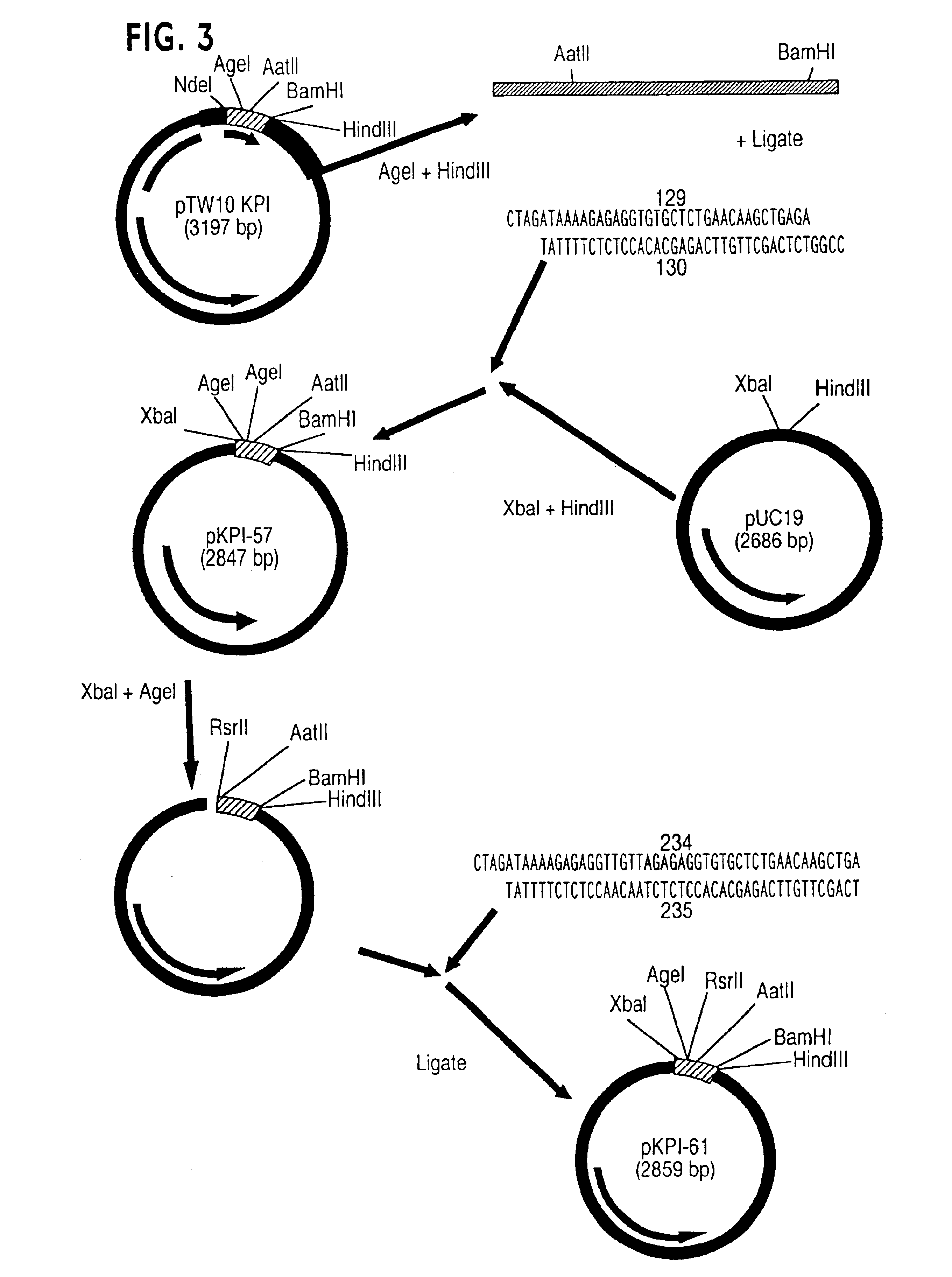Protease inhibitor peptides
- Summary
- Abstract
- Description
- Claims
- Application Information
AI Technical Summary
Benefits of technology
Problems solved by technology
Method used
Image
Examples
example 1
Expression of Wild-Type KPI (−4→57)
[0144]A. Construction of PTW10:KPI
[0145]Plasmid PTW10:KPI is a bacterial expression vector encoding the 57 amino acid from of KPI fused to the bacterial phoA signal sequence. The strategy for the construction of PTW10:KPI is shown in FIG. 1.
[0146]Plasmid pcDNAII (Invitrogen, San Diego, Calif.) was digested with PvuII and the larger of the two resulting PvuII fragments (3013 bp) was isolated. Bacterial expression plasmid pSP26 was digested with MluI and RsrII, and the 409 bp MluI-RsrII fragment containing the pTrp promoter element and transcription termination signals was isolated by electrophoresis in a 3% NuSieve Agarose gel (FMC Corp., Rockland, Me.). Plasmid pSP26, containing a heparin-binding EGF-like growth factor (HB-EGF) insert between the NdeI and HindIII sites, is described as pNA28 in Thompson et al., T. Biol. Chem. 269:2541 (1994). Plasmid pSP26 was deposited in host E. coli W3110, pSP26 with the American Type Culture Collection (ATCC), ...
example 2
Recombinant Expression of Site-Directed KPI (−4→57) Variants
[0179]Expression vectors for the production of specific variants of KPI (−4→57) were all constructed using the pTW113 backbone as a starting point. For each KPI variant, an expression construct was created by replacing the 40 bp RsrII-AatII fragment of the synthetic KPI gene contained in pTW113 with a pair of annealed oligonucleotides which encode specific codons mutated from the wild-type KPI (−4→57) sequence. In the following Examples the convention used for designating the amino substituents in the KPI variants indicates first the single letter code for the amino acid found in wild-type KPI, followed by the position of the residue using the, numbering convention described supra, followed by the code for the replacement amino acid. Thus, for example, M15R indicates that the methionine residue at position 15 is replaced by an arginine.
[0180]A. Construction of pTW6165
[0181]The strategy for constructing pTW6165 is shown in F...
example 3
Identification of UPS (−4→57) M15A, S17F) DD185 by Phage Display
[0209]A. Construction of Vector pSP26:Amp:F1
[0210]The construction of pSP26:Amp:F1 is outlined in FIG. 30. Vector pSP26:Amp:F1 contributes the basic plasmid backbone for the construction of the phage display vector for the phoA:KPI fusion, PDW1 #14. pSP26:Amp:F1 contains a low-copy number origin of replication, the ampicillin-resistance gene (Amp) and the F1 origin for production of single-stranded phagemid DNA.
[0211]The ampicillin-resistance gene (Amp) was generated through polymerase chain reaction (PCR) amplification from the plasmid genome of PUC19 using oligonucleotides 176 and 177.[0212]176 (SEQ ID NO:43): GCCATCGATGGTTTCTTAAGCGTCATGGCACTTTTC[0213]177 (SEQ ID NO:44): GCGCCAATTCTTGGTCTACGGGGTCTGACGCTCAGTGGAACGAA
[0214]The PCR amplification of Amp was done according to standard techniques, using Taq polymerase (Perkin-Elmer Cetus, Norwalk, Conn.). Amplification from plasmid pUC19 with these oligonucleotides yielded a...
PUM
| Property | Measurement | Unit |
|---|---|---|
| Power | aaaaa | aaaaa |
| Power | aaaaa | aaaaa |
| Volume | aaaaa | aaaaa |
Abstract
Description
Claims
Application Information
 Login to View More
Login to View More - R&D
- Intellectual Property
- Life Sciences
- Materials
- Tech Scout
- Unparalleled Data Quality
- Higher Quality Content
- 60% Fewer Hallucinations
Browse by: Latest US Patents, China's latest patents, Technical Efficacy Thesaurus, Application Domain, Technology Topic, Popular Technical Reports.
© 2025 PatSnap. All rights reserved.Legal|Privacy policy|Modern Slavery Act Transparency Statement|Sitemap|About US| Contact US: help@patsnap.com



